What is Omotenashi? About Japanese style hospitality
CONTENTS
John Mori meets with Japanese experts whose lives revolve around the concept of delivering the ultimate in customer satisfaction, and asks, What is Omotenashi?
What is Omotenashi or Motenashi?
Any foreigner who has lived in Japan for an extended period of time will have been asked this question: “What’s your favorite Japanese word?” In my own case I have often answered the enquiry with omotenashi and, without exception, my reply has garnered instant murmurs of approval. The tacit implication is that I have “understood.” But what, exactly, is it?
Omotenashi is a singularly difficult word to define, let alone translate. It is very close to the Western phrase ‘Hospitality’, yet it is palpably something else, one of those semi-mystical Japanese keywords that seem to tap into the very heart of the Japanese cultural DNA, yet remain somehow beyond literal explanation. One of my personal favorite attempts to decipher its meaning, comes from an unlikely source, the PR department of a major Japanese cosmetics corporation:
“Omotenashi is a word you have to translate with your heart” says their copy, “It is a subtle connection in which trust, pleasure and respect are interwoven in an approach steeped in a natural sense of deference; an exquisite approach to the art of receiving guests.” Not a bad stab at it, methinks.
My own attempt goes something like this: “Omotenashi describes an atmosphere of conviviality and welcome in which individual needs and preferences are catered to impeccably, and of which an essential element is the unobtrusive, meticulous attention to detail. The term is primarily used in modern Japan in the hospitality and service industries, most notably in high-end hotels and restaurants, though its use is not exclusive to those trades; it may even be used to describe the hospitality found in the confines of a private home.”
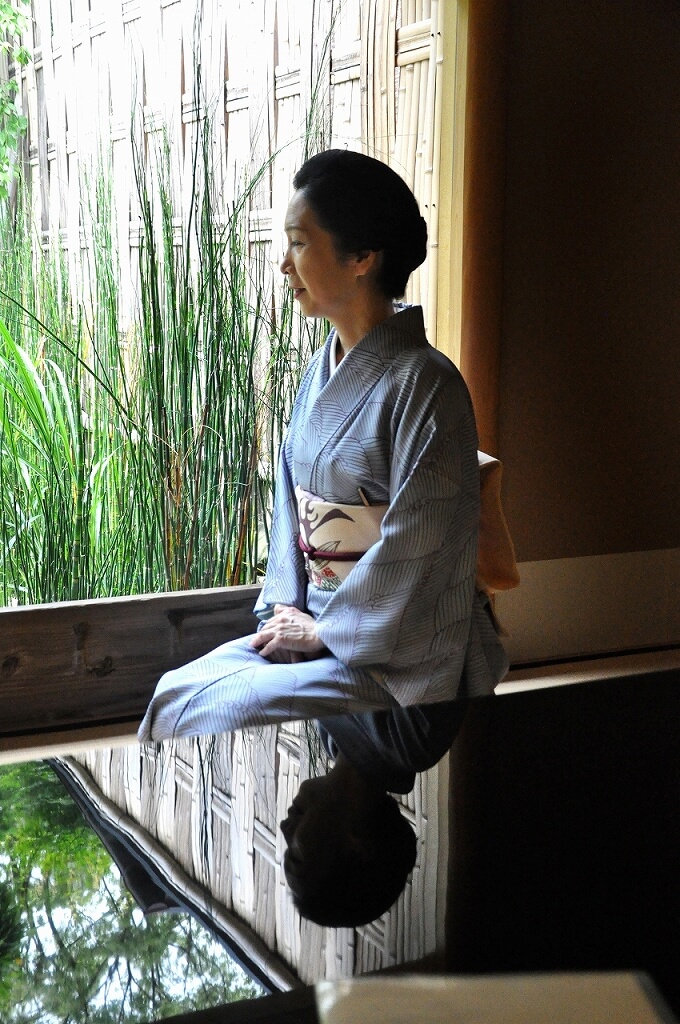
“Omotenashi is so much a part of my daily life, and such a joy, it is hard to really define. I would say that it involves providing our guests with a combination of yorokobi (‘pleasure; enjoyment’) and an escape from nichijo, (‘daily life; the mundane’). This might be a very simple thing to say, but when a customer leaves saying “Thank you, we really enjoyed ourselves,” it is a genuine treasure. Then I feel blessed to be an okami.
Kyoko Murata (proprietress at an upscale Japanese-style restaurant)
So begins Kyoko Murata, proprietress and okami (see boxed text) at Kikunoi Honten, Japan’s most famous traditional high class ryotei restaurant. Nestled in the leafy surroundings of Higashiyama, a stone’s throw from Kyoto’s Maruyama Koen Park, and the dining, entertainment and geisha district of Gion, Kikunoi Honten is a restaurant of legendary status and high repute. Its owner and master-chef is Yoshihiro Murata, Francophile, possessor of 5 Michelin stars, and internationally famous culinary star. Murata runs his kitchen with genius, and precision, but when it comes to the front of house hospitality, it is his wife Kyoko who is to the fore.
“We truly care about our customers,” she explains, “but it is an important part of our omotenashi that we don’t fuss over them too much. We must strike the perfect balance between being attentive yet not over-intrusive. Too much attention just leaves customers feeling uncomfortable.
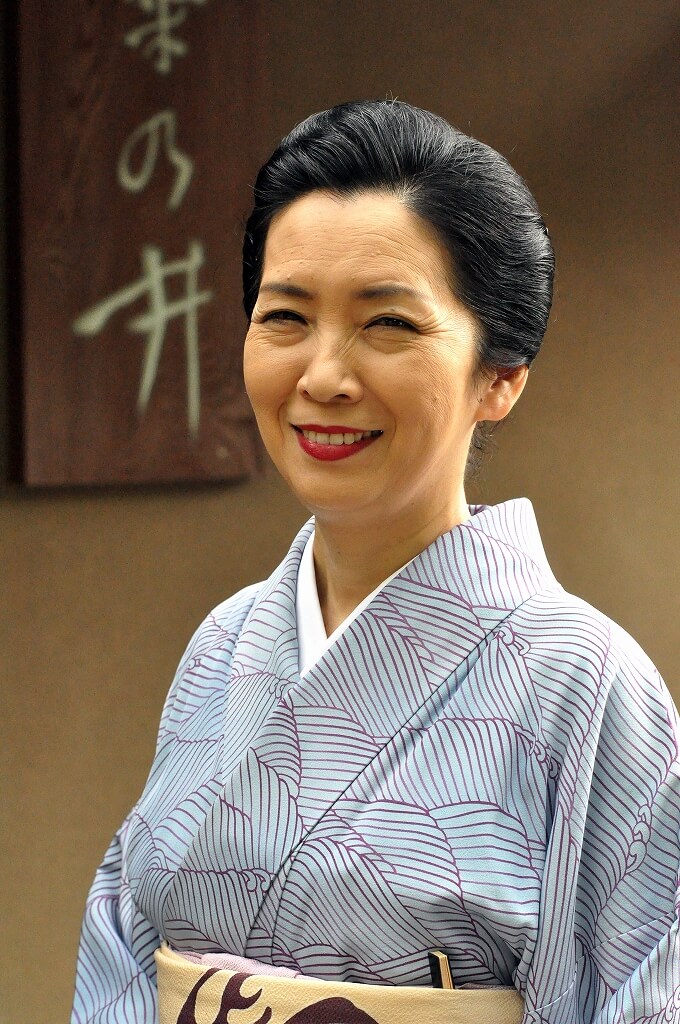
What is Okami 女将?
Elegant, charming, articulate, and beautiful, they are kimono-clad ladies who welcome you to their restaurant or ryokan. The Chinese characters for the term combine onna (woman) and the sho of Shogun, a fair indication of the combination of femininity and fortitude that this most exacting of jobs requires. No mere mangers or proprietresses these, they embody the very soul of omotenashi.
“Our omotenashi begins when we take a telephone booking, and then, in person, when we greet our customers on the ishidatami “stone tatami,” the pavement at the entrance to the restaurant. I have read quite a few books on Western hospitality, and noticed how much emphasis is placed on the job of the doorman or head waiter, but here in Japan they tend to receive very little attention. But they play a crucial role in omotenashi and should not be underestimated. Sweeping the genkan entrance-way, or welcoming guests inside, they are our first point of contact with our guests.”
“Once our waitresses put on the kimono that is the Kikunoi uniform, they are transformed. I like to think of us as supporting actresses in the larger performance. Or perhaps to use another theatrical image, we are like the kuroko of the Kabuki stage, the all-black clad stage assistants, so crucial to the performance but existing largely in the shadows.
“Because, of course, our food is the most important part of a visit to Kikunoi,” she continues, “ yet that isn’t by any means the be-all and end-all of the Kikunoi experience. My husband likes to say that the beautiful cuisine is 40%, the gorgeous environment and the impeccable, refined service 60%, in what he describes as our amusement park for adults.”
This observer can’t but help smile to hear these impossibly elegant, wholly traditional Japanese surroundings compared to something as seemingly brash as a theme-park, but the allusion does make sense when one considers that both depend upon a certain sense of wonderment, an experience ‘beyond normality’ for their success.
“Our service, and our omotenashi must provide beauty and a sense of luxuriance, but it is a subdued opulence, nothing brash or overtly sexy. Throughout our history we have provided a dignified omotenashi, one that is very personalized. We begin by establishing the individual guests’ reasons for coming here, and tailor or service accordingly. It is paramount that our customers never feel that a single moment spent at Kikunoi is time wasted.
“You must understand that people come to us for particularly special occasions, such as birthdays and omiai the arranged introductions that may potentially lead to marriage, and so it is our duty to take our responsibilities most seriously,” says Murata.
I ask if she can cite some examples.
“Two cases in particular spring to mind. In the first, two parents brought their young adult son to share lunch together. He was, it transpires, on the verge of running away from home, but over a long family discussion here in Kikunoi he was persuaded to stay.
“On another occasion, an old man, nearing the end of his life, made an advance reservation, and insisted on paying up front, just in case, to use his words, ‘I might not be here when the reservation day arrives’. Can you imagine the responsibility that one feels on such occasions? I am happy to report that the elderly gentleman was indeed able to attend, and enjoyed himself greatly.
“Knowing in advance that the two or two-and-a-half hours or so that guests spend here at Kikunoi is often serious, “quality time,” so our preparation too is serious, responsible work. We hope that when people leave, thanks to our meals and our omotenashi, they leave something of their hearts behind. Even if a guest visits us just the once, we want them to remember our meals and our service for the rest of their lives.”
I ask Murata about her own memories of receiving omotenashi. “I must have been around seven years old,” she explains. “It was something very simple. I dressed in kimono and went to a friend’s house to play, and her mother gave us ocha green tea and okashi Japanese sweets. She treated us just like adults. Even at that age, and in a private home, I was treated with the respectful kindness that omotenashi demands.
“I wasn’t aware of it then, but now I can see that in omotenashi there is always an element of deliberate understatement, as is fit for something which arose from the culture of tea and the tea-ceremony. This is perhaps what differentiates it from a Western idea of hospitality.
“My husband is often invited to France, where he always takes note of the ornate lavishness afforded to a guest. He smiles when he compares our humble offerings of okayu rice-gruel [Kikunoi’s okayu is sublime, dear reader] with the dramatic French dishes. In particular he recalls being served, on one occasion, Cervelle d’Agneau lamb’s brain - on a silver platter! You see, though our meals and service at Kikunoi are perceived by most of our Japanese customers to be ‘luxurious,’ it is in a very different, rather subtle way. Ours is a humble elegance, something akin to a beautiful but unadorned kimono, whose flamboyant design is willfully restricted to the material inner linings. It is very important that our omotenashi is not too overt.
“We have developed a phrase here at Kikunoi, that serves as a useful metaphor for our hospitality. We talk of our sanro, the ‘three drops of dew,’ each reminding us of our duties: the sweeping and the watering of the cobbled entranceway; the carefully crafted silken tassels that adorn the hanging scrolls in the tokonoma alcoves; and the soft misty spray of chilled water with which we dust our cold dishes. Our welcome; our rooms; our cuisine. The attention to detail is everything.”

Sachiko Nakamichi (a hotelier at a Japanese-style inn)
Sachiko Nakamichi, a hotelier, is owner and okami of the much-lauded ryokan Japanese inn, Beniya Mukayu, one of West Japan’s finest, located in Yamashiro Onsen in the Southern part of Ishikawa Prefecture. She talked about her and her establishment’s relationship to omotenashi.
“Preparation is everything, or at least nearly everything,” she confides. “I’d say that by the time a customer arrives at the entrance to our ryokan, 80 to 90% of our omotenashi is already in place. So, from those figures alone, we can see that ometenashi is not simply a face-to-face service. It goes far deeper than that.
“I feel that our remit here at Beniya Mukayu is to create an environment in which our customers, our guests, can experience something beyond the daily norm. It must be remarkable [she uses the very same Japanese phrase that Kyoko Murata uses, hinichijou, literally ‘outside the everyday].
“In that sense, our omotenashi began when we sat down to transform the old buildings that had stood on the site for decades, and essentially rebuilt everything to create our modern ryokan. The physical design and the conceptual design are all part of our omotenashi.
Beniya Mukayu is very much a 21st century ryokan with its state of the art TVs and yoga room, etcetera, yet its conceptual roots may be found in 4th century China, and the philosophical teachings of the Daoist master Zhuangzi. The ancient sage proclaimed “Empty rooms fill with light,” and Nakamichi and husband Kazunari took this wisdom to heart --- in a literal and metaphorical sense --- when they created Beniya Mukayu.
“Zhuangzi teaches that Everything is Nothingness,” explains Nakamichi, “and ‘Mukayu’ means ‘The State of Non-Existence.’ Another way to understand it is if we take the meaning as ‘Things in their natural state, as is. Unadorned.’
“So we looked closely at our physical surroundings, our position here in nature, with the giant red pine, and began to construct a ryokan in harmony with our natural surroundings. We listen to the voice of nature. The end result looks so natural, in fact, but nothing was left to chance. As with our architecture, so it is with our menus, everything is planned. And so, in the large degree, it is with our omotenashi.
The architecture at Beniya Mukayu is unquestionably beautiful, but it is a beauty born of simplicity and nature, not extravagance or luxurious design.

“In trying to create the perfect environment for our guests, we are not concerned with opulence, or that richness of beautiful design that you will find, for example, at Kikunoi-san” explains Nakamichi, “It is in fact the opposite.
“For example, our theme color is white, a base tone that we adorn with the deft, simple touches of nature, with our use of wild flowers. I sometimes think of Mukayu as an empty glass bowl into which nature and light naturally flow.”
If this sounds idyllic, so it should. A stay at Beniya Mukayu feels idyllic. Yet as our genteel host explains, a great deal of hard work has gone into creating such a peaceful environment.
Sachiko Nakamichi giggles as she highlights the cracks that run across the ryokan’s expansive hallway. “They look natural, don’t they? We had to draft in the most famous plasterer in Japan to create that. The floor is made of a very special material, diatomite earth, only generally used on walls, and our master craftsman from Kanazawa had to run test after test until he was confident of getting such a huge space to imperfect ‘perfection.’
“Designing our entrance garden was another challenge. The gardeners wanted to create something very traditional, formalized, but I wanted to retain a spontaneous, semi-wild quality that is inviting to guests from the very moment they arrive. They were bemused when I created a see-through, glass sign adorned with the Mukayu name, through which you can view the flowers, but in the end we were vindicated. Guests love our gardens.”
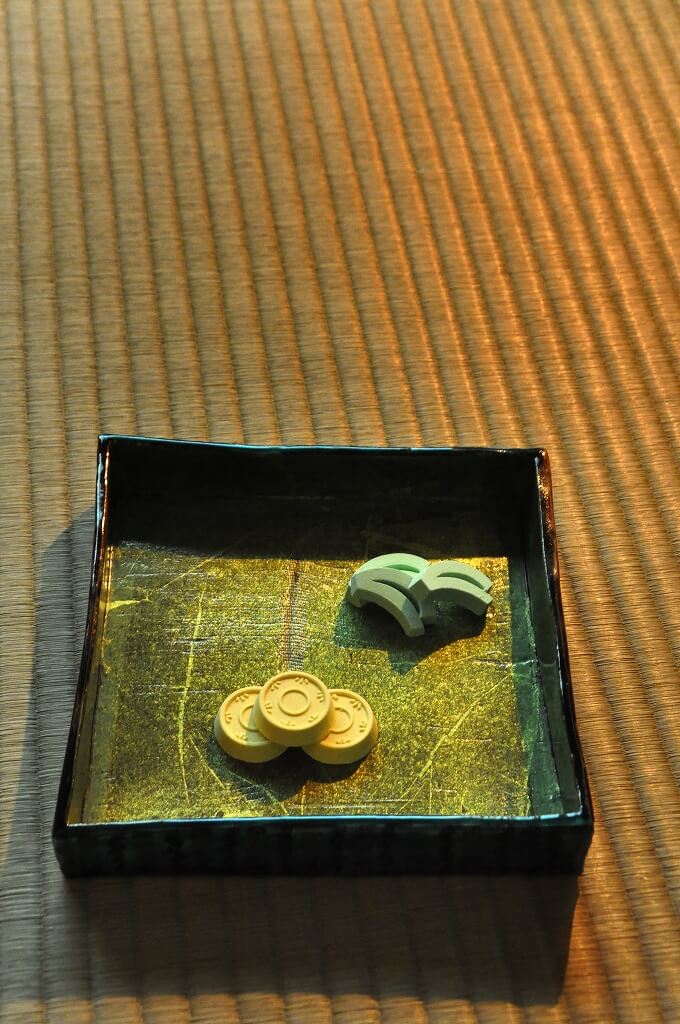
Wherever you go in Beniya Mukayu, you find the most exquisite wild-flowers, seasonal treasures which the staff hike into the nearby mountains twice a week to find.
“For us flowers are a symbol of purification, catharsis and rebirth, and we go to great lengths to place them throughout our rooms” explains Nakamichi, “Just another example of our omotenashi.” It comes as little surprise, then, to hear that Nakamichi’s earliest exposure to omotenashi came through flowers.
“My mother loved ikebana flower arranging,” she explains, “and grew her own flowers with that purpose in mind. She picked flowers in every season to decorate the house. She wasn’t in any way ‘showing off’ for guests. It was just for the pleasure of the family. When I look back to my childhood, I now realize that it was her way of educating me with an aesthetic sensibility, and teaching me omotenashi.”
Nakamichi’s mother’s efforts have paid off handsomely, with Beniya Mukayu garnering praise in all quarters, both domestically and overseas. Nakamichi is far too genteel a host to say so, but clearly the plaudits are hard earned.
“Our Japanese guests are, in fact, extremely demanding,” she does confide, “and it is through minute attention to details, with our flowers, with our food, with our rooms, with our décor, with our hot-spring baths, with our service, that we try to meet everyone’s individual needs. For example, certain customers may say that they object to camellias decorating the room as the flower’s short lifespan is symbolic, for some people of death. We make a record of their wishes, and on their next visit they can be assured that different seasonal flowers will be used. This too is omotenashi.”
Lloyd S. Nakano is a Hospitality Designer and Educator based in Ichigaya, Tokyo. Having cut his teeth in the hotel industry at the Royal Hawaiian Hotel in Waikiki in 1969, he later worked at the Four Seasons Chinzan-So in Tokyo, before becoming General Manager at the Rosewood Hotels and Resorts Seiyo Ginza, a position he held for 11 years. A Hawaiian who can intuitively understand Aloha Spirit, and a globally aware professional familiar with the Balinese concept of Keramah Tamahan hospitality, Nakano’s years in the Japanese hotel industry allow him a rare comparative overview of different cultures’ takes on hospitality.
“Initially I perceived omotenashi as an abstract, inheritable behavior, but over many years of observing Japanese hotel professionals in action, I came to believe it could be a measurable, quantifiable, and thus teachable reality. Working for a US-owned hotel in the Japanese market, I slowly came to believe that a Japanese mindset (less is more) could be married with a Western idea (more is better) after all.
“If you confuse omotenashi with the Western concept of hospitality, however, you are making a fundamental mistake. The term grew out of Zen Buddhism and the tea-ceremony, which is essentially an art that is perfected with a minimum of effort, a minimum amount of movement, with nothing superfluous, everything precise, everything just so. The practice must be repeated over and over again until it is perfect. Thus observer and participant become awed by the simplicity of the act. This is the heart of genuine hospitality.”

Randy Channell Soei (a foreign tea master)
Canadian-born Tea Master Randy Channell Soei lectures extensively on Chanoyu the Way of Tea and the tea ceremony, and appears regularly on Japanese TV and in international media. He is owner of Ran Hotei, a Japanese style café and Gallery in Kyoto’s Sanjo Arcade.
“Omotenashi is the respectful interplay of host and guest without ulterior motives to carry out whatever it is they set out to accomplish. I believe the concept of ichigo ichie (one time, one meeting) also plays an important role in omotenashi. To put it simply, each meeting is unique, and should be enjoyed to its fullest by both host and guest. Nowadays as the term has become so linked with the service industry it seems to only mean the host doing his or her best to please the guest. I feel though that there is also a responsibility on the guest’s side to reciprocate the omotenashi shown, so there is not only a “good host” but also a “good guest.”
“As a follower of the Way of Tea, it means I strive to put the Four Principles and Seven Rules of [16th Century Tea Master] Rikyu into my daily life. I believe they are integral to a proper understanding of omotenashi.
“Rikyu’s Four Principles are: Harmony, Respect, Purity and Tranquility. His Seven Rules are: Make good tea; Lay the charcoal so it boils the water; In winter suggest warmth, in summer coolness; Flowers as they are in the field; Be early for the appointed time; Even if it isn’t raining prepare an umbrella; Be considerate of other guests.
“These maxims are hundreds of years old, yet they are valid today and will be valid hundreds of years from now. If one looks into them a little deeply, it’s easy to see that they pertain to many things beyond the realm of tea.
“Everyone, knowingly or not, experiences or performs omotenashi in some way or another. It is at the core of the Way of Tea, so I experience it both as guest and, more often, as host. I hope that the customers in my store, Ran Hotei, experience it too!”
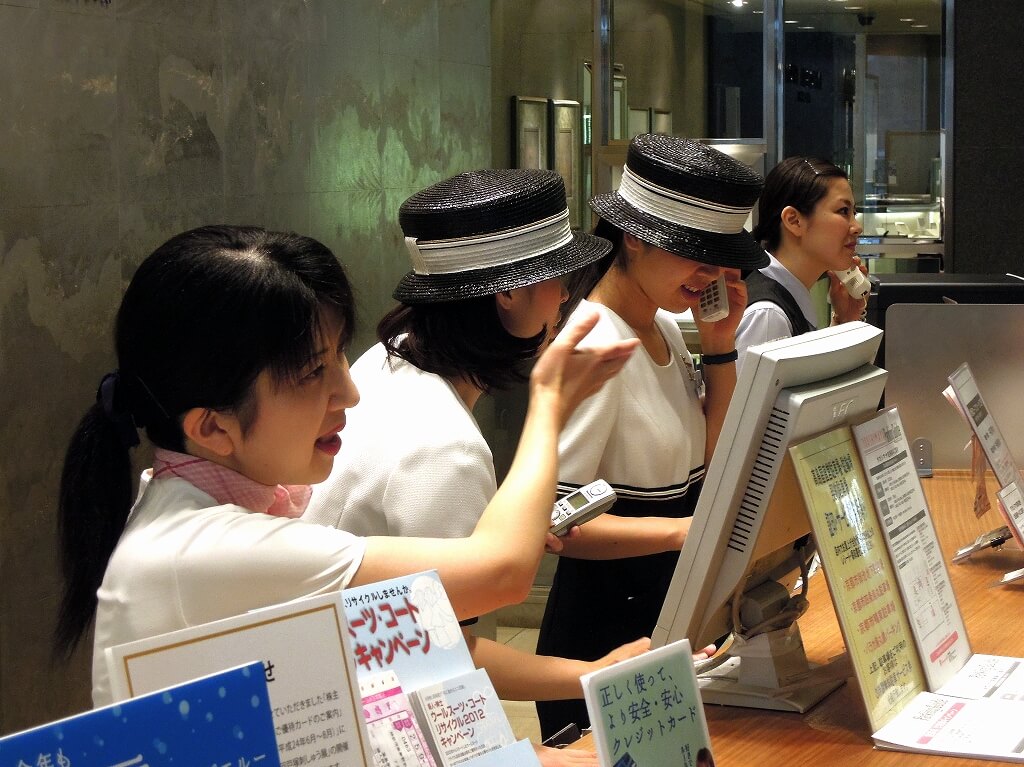
Takashimaya Department Store (a veteran clerk at a prestigious department store)
Nowhere is Japan’s omotenashi more evident than in its palatial department stores. At the prestigious Takashimaya in downtown Kyoto, immaculately clad shop assistants treat each customer with the utmost courtesy. Uniformed “elevator ladies,” selected for their demure poise and feminine grace, announce the products and services available on each floor. One cannot imagine that this physically demanding and extremely repetitive job would be much sought-after overseas, but in the Japanese department store universe, it is a much coveted position, its status revealing how seriously the company takes its public demonstration of omotenashi. Even higher up the scale are the elegant ladies who staff the information desk: all-knowing, ever alert to customers’ every need, and the epitome of efficiency and charm.
“We are trained in the minutiae of hospitality,” says Ms T.O, a 25 year veteran of the department store world, whose self-effacing modesty demands that she remains initials on this page. “When you have been doing this work as long as I have, omotenashi really becomes second-nature. We guide individual customers across the busy crowded spaces to find the precise product they are looking for, always with a smile, no matter how busy we might be with the other demands of our workload; we escort elderly customers down to the exit so that they feel safe, cared for, and we will hail them a taxi if needs be; we are taught how to wrap the purchases in exquisite fashion which we present to the customer again with a smile, and with a bow; we bow too when we leave the service floor, taking care not to be so insensitive as to turn our backs on the customers. Always we employ keigo, the “respect language” of Japan. We Japanese have a saying that sums up our ethos: “Okyakusama wa Kamisama desu (The Customer is God).”
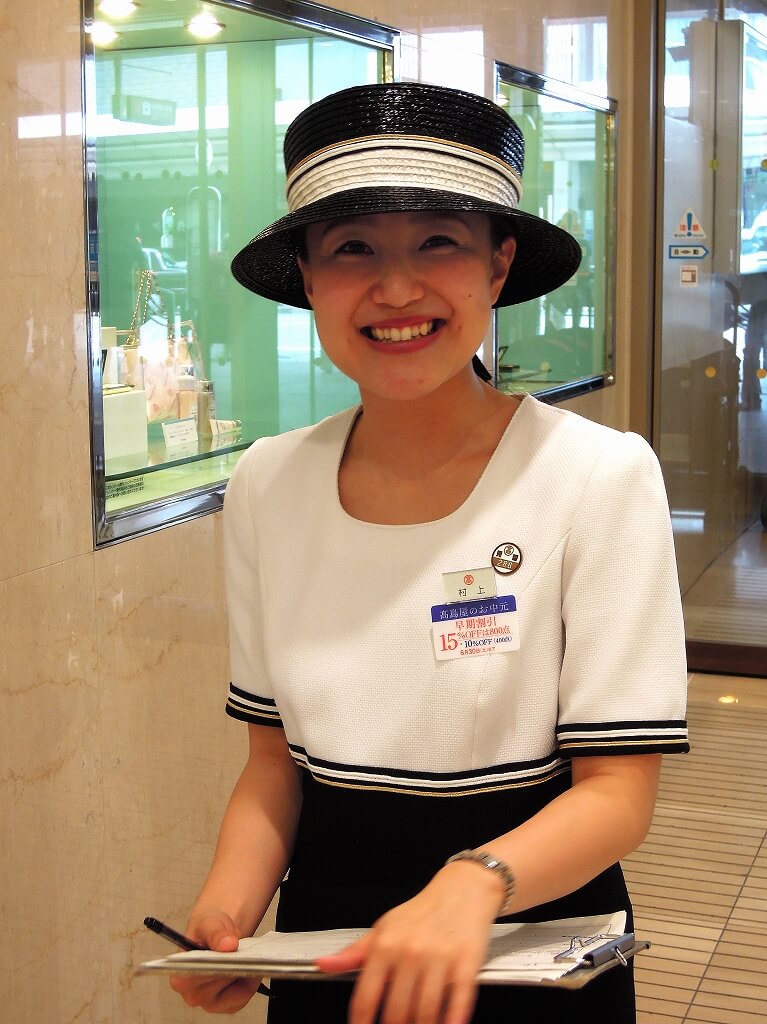
So, in conclusion, how does “Omotenashi” differ from “Hospitality”?
“I was rather hoping that you would tell me that” giggles Sachiko Nakamichi. “Mmm… it’s hard to explain precisely, because I am so wrapped up in it” says Kyoko Murata. “It just feels different,” adds T.O, “something uniquely Japanese, a deep part of our culture.”
Even the experts themselves find it hard to articulate, and perhaps there lies our key to understanding it. Omotenashi is hospitality based on a deep lying shared set of assumptions and behavioral codes. As Lloyd Nakano argues, the forms of omotenashi may be learned, copied – the attention to detail, the self-effacement, courtesy and consideration taken to the nth degree - but at the end of the day this writer can only but feel that omotenashi is inherently instinctive. Come to Japan and experience it for yourself. Then you will begin to understand.
Read more about Omotenashi (Japanese hospitality): Tessei, The Shinkansen Omotenashi: The Seven-minute Short Play with Winning Applause

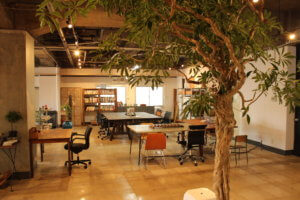
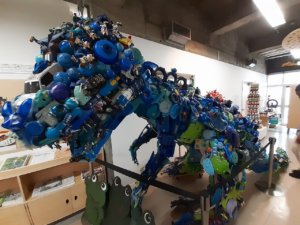
One thought on “What is Omotenashi? About Japanese style hospitality”